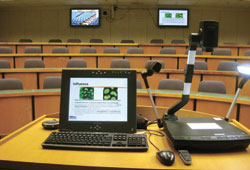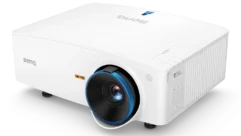

Distance Learning: Think Locally
The University of Georgia’s college of Pharmacy has a respectable history with distance learning, but it will push even more confidently into the 21st century when its 84,000-square-foot addition opens this fall in Athens.
CHALLENGE: Take the traditional distance learning paradigm and design systems that also enable team collaboration at a more local level.”The kids are going to figure out a way to capture this content whether you do it for them or not,” Jones says, while noting the TCS lets instructors decide the timing, availability, and selection of published course materials.
At the University of Georgia’s College of Pharmacy, new classrooms are designed to pull in students from other campuses.
Credit: Sarah W. Jones
SOLUTION: Forget desktop conferencing and design distance learning systems that automatically adjust for group participation as students move around lecture halls and work together on assignments.
The University of Georgia’s college of Pharmacy has a respectable history with distance learning, but it will push even more confidently into the 21st century when its 84,000-square-foot addition opens this fall in Athens. Two 200-seat lecture halls, two conference rooms, four classrooms, and a multipurpose room will soon be outfitted with the latest conferencing and presentation technologies, all controlled with minimal intervention from a new master-control room. The Atlanta-area AV design firm Waveguide Consulting was hired to spec the new addition.
Room With A View
The challenge was clear from the get-go. “The ideal distance-learning environment is usually limited to 30 people,” says Sarah Jones, program director of the school’s Millikan Educational Resources Center. “We had to figure out how to work with them to meet our distance-learning needs with our large class size. Instead of a traditional theater setting, they’re going to have more desk space so they can collaborate with people behind and in front of them.”
Distant Diagnosis: Western Nebraska
When building a distance learning system, the goal is to create something that makes it seems like the distance doesn’t exist. But tell that to the support staff that may need to trouble-shoot technology at the various end points in a conferencing system.
Last year Western Nebraska Community College decided to replace its 10-year-old teleconferencing system with something more powerful. The new system would serve at least 120 hours of classroom time per week to 11 counties, seven classrooms in three separate locations, and up to 21 high schools throughout the state. Locations could be up to 85 miles apart.
Among the equipment integrated by Dascom Systems Group were 14 ClearOne Converge Pro professional audio conferencing and sound reinforcement systems. Dedicated T-1 lines support the AV conferencing and distance learning applications. Ethernet connectivity enables remote diagnostics via the Converge Pro platform.
With ClearOne’s Converge Console software, each unit can be configured remotely, with changes to the entire system made from a single location. When problems arise, the software allows the school’s team to perform diagnostics remotely. And it’s set up to record and initiate certain management tasks automatically, such as diagnostics, microphone tests, and logging.
Waveguide’s biggest challenge has been coordinating each lecture hall’s Shure MX 392/C push-to-talk microphones, says Waveguide project manager Pat Durbin. It requires controlling the microphones through Biamp DSPs, specifically with AEC2HD echo-cancelling input cards.
“We’ve got it set so that only four mics can be on at any time,” Durbin says, to minimize extraneous noise; the instructor’s mic is always on. The Biamps also perform equalization and compression, but are mostly “set and forget.” Thirty Atlas Strategy 2 8-inch ceiling speakers are separated into six zones, and automated sound reinforcement helps people in the far corners of the auditorium hear each other without feedback. Two 12-inch Tannoy V12HP speakers broadcast program sound.
UGA wanted HD video throughout. A 132- by 235-inch Stewart custom screen hangs in front, showing images thrown by an 8,000 lumen Digital Projection Titan HD-600 projector. Each hall has a 42-inch, 1920×1080 Panasonic TH42PF11UK plasma screen mounted on the front row “modesty panel,” giving instructors a view of conferees at the other end.
Durbin says each hall sports four Sony EV1-HD1 PTZ cameras and a single Wolf-Vision VZ-9 document camera. Instructors carry a Smart Technologies Sympodium monitor around to annotate documents and control the presentation and speak into a Shure lavalier wireless mic. AMX equipment, including a 17-inch touch panel and NetLinx controllers, provides room control and connects the AV devices over IP.
The Sympodium also serves as a confidence monitor for the presentation–but not the video feed–so there’s no need for a dedicated screen. When the instructor steps on a Vaddio TrackVIEW mat in the front, a rear camera zooms in on the podium. Step off, and the video switches to the wide shot. Two rear-facing cameras zoom in on half-dozen or so students around the person with the active mic. Durbin says he designed the lighting to give remote conferees a brighter image and added acoustic paneling, even in the smallest rooms.
The multipurpose room has four 50-inch Panasonic TH50PF11Uks in its center so students can see close-ups of teacher demonstrations caught by two cameras. The larger of the two conference rooms has a front-projection, 4,800 lumen Epson PowerLite Pro G5200WNL, three Clock Audio CS2-RF or CS3-RF mics, and three cameras: two Sonys and one WolfVision, the same as those in the lecture halls.
Equipment List
Below is a partial list of the equipment installed by Waveguide Consulting for the University of Georgia’s College of Pharmacy.
- AMX NetLinx controllers
- Atlas Sound Strategy 2 8-inch ceiling speakers
- Biamp Nexia digital signal processors
- Dell PowerEdge media storage server
- Digital Projection Titan HD-600 projector
- Ensemble Video Web publishing server
- Extron Crosspoint wideband RGBHV routers w/audio
- Panasonic 42- and 50-inch plasma displays
- Shure MX 392/C push-to-talk microphones
- Smart Technologies Sympodium ID-350
- Sony EV1-HD1 PTZ cameras
- Tandberg Video Communication Servers
- Various Tandberg MXP codecs
— Waveguide Consulting
A master control room sits approximately 200 feet from the first-floor lecture hall and contains a video codec “farm” so the distance-learning rooms don’t need their own. The initial spec called for four, rack-mounted Tandberg 6000 codecs, but UGA is considering newer, C60 models, Jones says. The room doesn’t have a control panel, per se, and should run largely unattended–Jones oversees MERC with one other employee–but Durbin says she will be able to check status visually on the Biamp DSPs and Tandberg codecs, and use a monitor to see the video that is transmitted to remote viewers.
Group Think
The college doesn’t offer individualized learning that lets students link in from their desktops. Group conferencing better suits its teaching style. “All of our students are traditional in that we have face contact with all of them,” Jones says.
An assortment of pre-owned point-to-point and multipoint videoconferencing units allow faculty in Savannah and Albany to teach classes at the other sites. The Athens hub has 11 Tandberg codecs. Two Video Communication Servers handle call control and firewall traversal. An Ensemble Video server from Symphony Video allows publishing to the Web.
Last year, the college acquired a Tandberg Content Server (TCS) to manage educational content, and a Tandberg Management Server for coordinating conference calls.
Jones says the on-demand learning enabled by the TCS has drawn concern from administrators who worry it will make it too easy for students to skip class. But the Web 2.0 generation, with its iPods and Facebook pages, might be driving the higher-ed bus just like baby boomers did decades ago. Jones plans to offer a new TCS feature that uploads content to iTunes U.
A schematic drawing of one of the school’s new classrooms, which will be equipped with the latest AV and conferencing technologies.
Such empowerment is the goal of distance learning, these experts say, but it’s not just for teachers. As born masters of Web technology, today’s students hold the power, too. “It all comes down to a person creating content and becoming their own publisher,” says Lance Ford, a Tandberg employee who trains UGA teachers. “I have just seen students’ eyes light up when they are allowed to drive this technology.”








